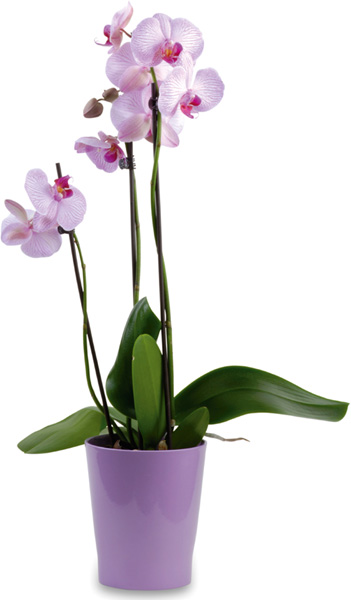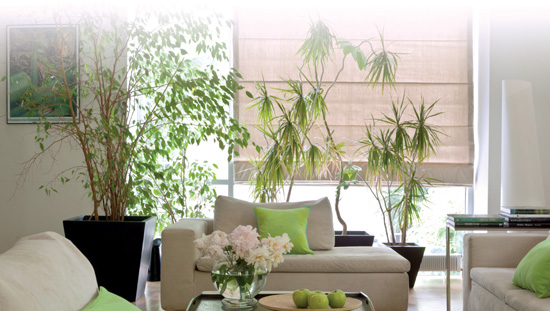Indoor plants
Plants add atmosphere to a home. Tall specimens such as ficus or palm trees act as accents, while smaller ones can decorate a windowsill. When choosing a plant, consider carefully where you are going to put it in order to enhance the decor and ensure its survival.
Armed with a few tips and patience, anyone can care for a variety of plants that will help enhance a living space. And remember, a room with plants is known to help lift the spirits.
GOOD TO KNOW 
The right location
Besides water, plants need light to thrive. A window facing south that gets plenty of sun is ideal for cacti and succulents. Ferns, orchids, peace lilies and palms prefer a north-facing window or relatively dark areas of a room.
A HEALTHY room climate
Plants are not only beautiful, they also increase the humidity level and oxygen content of a room during the daytime. This is good for the climate and, ultimately, for your health. It’s especially important in winter, when heating can dry the atmosphere.
• Plants are particularly effective at counteracting the release of volatile and potentially harmful chemicals from various substances (such as insulation, plywood or varnish) at normal atmospheric pressure—and contributing to balanced internal humidity. Good varieties to choose include Mexican fortune tree (Pachira aquatica), dragon tree (Dracaena), ficus, rubber plant, weeping fig, umbrella tree, Boston ferns, palm trees and peace lilies.
• Don’t keep plants in a bedroom because they use up oxygen and produce carbon dioxide at night.
• Bear in mind that big plants such as dragon trees and palm trees produce more humidity than smaller ones.

When properly cultivated, orchids will flower over and over again for years.
WATERING plants correctly
Many plants do well when watered from above, but there are myriad factors to consider, depending on the size and species of plant. One general guideline to follow is that you should always use water at room temperature. Another is always to water plants with furry leaves, such as African violets, from below to avoid damage.
• Put bulbs and other plants with sensitive roots, such as poinsettias, in a large bowl and water them from below to keep the bulbs or roots from rotting. Also, check planters about an hour after watering and drain off excess water.
• Keep rainwater and stale mineral water handy, as both are good for watering plants, as is cooled, salt-free water that has been used for boiling eggs.
• Let tap water sit overnight before you water plants with it. Fluoride and other minerals dissipate or settle when the water is left to sit.
• Immersion can be beneficial to many plants, including cacti and citrus species. Immerse the root ball in its pot in a large container of water. It is saturated when no more air bubbles rise.
• Spray plants occasionally. Use lime-free water to keep limescale from building up. Pamper plants (especially cacti and those with large leaves) with a cleansing shower twice yearly: Put them out in the rain or spray them with a showerhead. Tip cacti pots to prevent water from running directly into them.
REGULAR care
With a little tender care, plants will reward you with healthy foliage and gorgeous flowers.
• Check new plants thoroughly for pests before buying. Indoor plants can be susceptible to mites, aphids and other troublesome creatures that spread easily.
• Dust plants carefully now and then to let leaves breathe, giving particular attention to the undersides.
• Wipe plants with larger leaves with diluted beer to make them shine.
• Remove wilted flowers and leaves immediately to keep plants looking good and to help to prevent them from attracting bugs.
• Prevent a harmful accumulation of water by occasionally loosening the soil. When repotting, be sure the new pot’s drain holes are clear and always use new potting mix. Choose a good-quality mix that has controlled-release fertilizer and water-absorbent crystals.
• A mixture of sieved compost, garden soil and sand makes good potting soil. Also, eggshells (for calcium), coffee grounds and black tea make excellent natural fertilizers.
• Leaving plants exposed to heat or drafts is the equivalent of leaving outdoor plants unprotected from the elements.
• Water plants more sparingly during the colder months, as winter is a time of rest. Also, keep them in rooms with cooler temperatures if possible.
CUTTING back
Trim fast-growing plants regularly during the summer. Careful pruning controls plants and encourages growth. It will help them grow stronger and is a good way to shape certain species.
• Prune woody plants once a year, but timing depends on the type of plant. Plants that flower before midsummer are best pruned immediately after flowering.
• Increase the number of shoots and flowers by cutting back the main shoot. This will cause the plant to sprout new shoots.
• Make the cut clean, no matter why or where you prune. Use a sharp knife or pruning shears.
A garden in a bottle
A terrarium is the perfect way to bring a little greenery to a cramped space. This is how to assemble one.
one Line the bottom of a large, big-bottom bottle with gravel. Then, use an ice cream stick to extend the handle of a spoon and a fork (use some tape to attach them).
two Put a layer of soil on top of the gravel and smooth it out. Use a cardboard funnel to keep the sides of the bottle clean.
three Insert suitable plants, such as ferns, small trailing figs and ivy, using the spoon and the fork as tools. Don’t plant them too close together, as they need room to grow.
four Water the plants carefully with cooled boiled water, and keep the bottle tightly sealed. If the bottle fogs up, you have overwatered it.
five Don’t place the bottle garden in direct sunlight or on or near a heating unit.
INDOOR PLANTS HELP to give ROOMS a PLEASANT FEEL.



